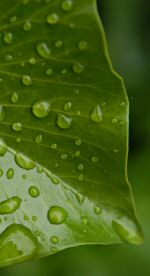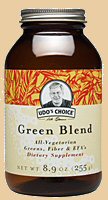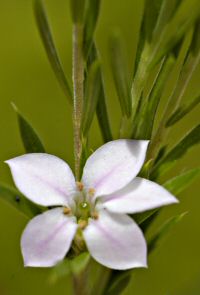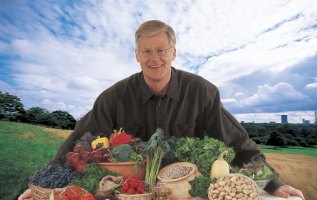|
|


绿色植物是我们最重要的食物来源,因为它们可以提供我们所有健康所需要的必需营养成分。它们既是我们的食物,又是我们的药物。几乎每一项健康的问题都可从摄入绿色食品而裨益。其中最好的是有机绿色食品,因为它们富含必需的营养素。
「人们不能在无法长出绿色植物的地方生活」
请下载伍德精选绿中宝的PDF文件(457K—仅限于英文) (如欲阅读PDF文件,须使用Adobe公司的免费
Acrobat
Reader)
我们这里所指的「绿色生物」是包括生长在咸水及淡水中不同种类的植物(藻类)、陆地上的植物、由陆生状态又回到水生环境的植物,这些食物的共通性是它们都是绿色的。「绿色生物」是人类健康及再生的最基本的要件。自古以来,它们就是提供生物成长取之不尽的食物来源。

生物学家认为,陆地上的植物是从单细胞的水生生物进化而来,它们大约在五亿年前才开始出现在陆地上。植物以及它们的绿色祖先都富含有镁的叶绿素。叶绿素是在植物的叶绿体中绿色的色素。叶绿素的功能是使植物体吸收太阳光能并进行光合作用,这使得地球成为一个绿色的星球。
「绿色生物」在哪里可以找到?「绿色生物」占据地球的几乎所有地区。它们可以出现在花园、森林中,田野、草地上,山上、谷地、海洋中、窗台上(从种子里冒出来)及室内的花盆中。它们包括草、叶、药草、藻类、海草、阔叶植物、树、苔藓、地衣、蕨类、灌木、杂草以及许多其他植物。

在希腊语里,"phyto"意思就是植物。因此phytochemicals一词按照定义所指的就是来自植物的具有生物活性的化合物。它们在植物体内所发挥的是免疫系统的功能,使植物能够抵抗所受到的疾病和病毒的侵害。植物化学品决定植物的颜色、口味,并帮助植物机体为存活而必须完成的许多生物学方面的任务。
植物中有数千种植物化合物。人类直到最近才开始对这种十分有价值的食物化合物的分子结构进行研究。这类物质的具体实例有:类胡萝卜素、类黄酮、植物甾醇、多酚类、木脂素、硫化物、姜黄素、皂角苷、香豆素、萜烯醇、邻苯二甲酸以及其他的许多物质。随着研究的不断进展,我们对这些物质的本质及其如何帮助人们保持健康,将会有新的了解
植物营养素指的是可作为食物的植物性化学物品。植物性药物可以诱发哺乳动物身体系统的生物反应,这些反应总是能降低一或数种慢性疾病的风险。自有人类以来人就已经善用富含植物性化学物的绿叶和植物的其他部分,从摄取这些物质来改善健康。
它们是我们的食物,又是我们的药物。如果是绿色植物无法生长的地方,人也无法在那里过活。

绿色生物为我们提供了以下这些谦卑的服务…
- 它们为我们制造呼吸所需的氧气已达30亿年之久(蓝绿藻是最早出现能进行光合作用的生物);
- 它们为我们提供水并使土壤保有水份;
- 它们将矿物质从岩石中溶解出来并加以吸收,使得矿物质能够为人所用;
- 它们为我们制造生命所必需的维生素;
- 它们制造了氨基酸和蛋白质,以及必需脂肪酸和油脂;
- 它们制造了糖类和淀粉,这些都是我们的细胞所使用的燃料。
- 它们可以提供纤维, 如果未经加工,它们还可提供我们消化酵素及益生菌;
- 它们是我们最大的抗氧化剂来源;
- 它们提供我们植物营养素──天然的药物;
- 它们可以使我们的身体呈碱性这是较为健康的状态;而且
- 为我们生产出牛排(牛靠吃草而成长)!
绿色植物可以改善人们的健康并减缓、预防或逆转退化性疾病。伍德精选绿中宝就含有所有这些促进健康的有益成份。

几乎所有的身体疾病都会因进食绿色植物而受益。有机的新鲜绿色植物是最好的,因为它们富含必需的营养素。有机的绿色植物可以榨成汁,或调拌成比较容易消化的食物;可以清蒸或水煮,或干燥后久藏,后者对工作繁忙或旅行的人尤为重要。

绿中宝可以提供:
- 50种超级食物、食品浓缩物以及植物萃取物;
- 来自9种不同来源的绿色植物混合物,其中包括:有机苜蓿、大麦、裸麦以及野燕麦粉;螺旋藻;小球藻、花椰菜、洋香菜及甘蓝菜;
- 从有机亚麻籽、葵花籽、芝麻及南瓜籽、稻子和燕麦胚芽制得的欧米茄-3和欧米茄-6必需油脂(如欲知详情,请参阅油品配方网页);
- 来自种子和绿色植物的蛋白;
- 两种纤维;特别富含水溶性的(植物分泌的)黏液;
- 来自草本植物的植物性营养素及抗氧化剂,它们可以维持人体内脏的功能,如:免疫系统、心血管系统、消化系统、肝脏、肾脏和胰脏;
- 来自最精良蔬菜的浓缩物,它们包括:胡萝卜、蕃茄、甜菜、羽衣甘蓝及其它蔬菜。
- 它们的碳水化合物含量低,因此对减轻体重及葡萄糖稳定性都有裨益。
- 这是一个完全的素食餐;
- 这是一种不含乳制品、麦制品、酵母制品及其他常见过敏原的食物;而且
- 这是一种以自然风味来改善口味的绿色食品。
- Murray, Michael, and
Pizzorno, Josheph, Encyclopedia of Natural Medicine. Prima
Publishing, 1998.
- Jensen, Bernard, The
Chemistry of Man. Bernard Jensen Publisher, 1983.
- Murray, Michael T, Encyclopedia
of Nutritional Supplements. Prima Publishing 1996.
- Weiss, Rudolf Fritz,
Herbal Medicine. Beaconsfield Publishers Ltd., 1998.
- Campbell, Neil A., Biology,
Fourth Edition. The Benjamin/Cummings Publishing Company, Inc.,
1996.
- Willard, Terry, Textbook
of Modern Herbology. Progressive Publishing Inc., 1988.
- Vanderhaeghe, Lorna,
The Immune System Cure. Kensington Publishing Corp., New York,
1999.
- Gursche, Siegfried,
Encyclopedia of Natural Healing. Alive Books, Burnaby, B.C.,
Canada, 1997.
- Rauma AL, et al., Antioxidant
status in long-term adherents to a strict uncooked vegan diet. Am
J Clin Nutr 1995 Dec;62(6):1221-7. Department of Clinical
Nutrition, University of Kuopio, Finland.
- Craig W.J., Health-promoting
properties of common herbs. Am J Clin Nutr 1999 Sept;70(3
Suppl):491S-499S. Department of Nutrition, Andrews University,
Berrien Springs, MI 49104-1210, USA.
- Kay Ra., Microalgae
as food and supplement. Crit Rev Food Sci Nutr 1991;30(6):555-73.
Cell Tech, Klamath Falls, Oregon.
- Beecher G.R., Nutrient
content of tomatoes and tomato products. Proc Soc Exp Biol
Med 1998 Jun;218(2):98-100. Food Composition Laboratory,
Beltsville Human Nutrition Research Center, ARS, USDA, Maryland
20705, USA.
- Sinatra S.T., DeMarco
J., Free radicals, oxidative stress, oxidized low density lipoprotein
(LDL), and the heart: antioxidants and other strategies to
limit cardiovascular damage. Conn Med 1995 Oct;59(10):579-88.
Manchester Memorial Hospital, USA.
- Bland J.S., Phytonutrition,
phytotherapy, and phytopharmacology. Altern Ther Health
Med 1996 Nov;2(6):73-6. HealthComm International Inc, Gig
Harbor, Wash., USA.
- Kurzer M.S., Xu X.,
Dietary phytoestrogens. Annu Rev Nutr 1997;17:353-81.
Department of Food Science and Nutrition, University of Minnesota,
St. Paul 55108, USA.
- Joshipura K.J., et al.,
Fruit and vegetable intake in relation to risk of ischemic
stroke. JAMA 1999 Oct 6;282(13):1233-9. Department of
Epidemiology, Harvard School of Public Health, Boston, Mass,
USA.
- Nebeling L.C., Changes
in carotenoid intake in the United States: the 1987 and 1992
National Health Interview Surveys. J Am Diet Assoc 1997
Sep;97(9):991-6. National Cancer Institute, Bethesda, Md. 20892-7326,
USA.
- Simopoulos A.P., Essential
fatty acids in health and chronic disease. Am J Clin Nutr 1999
Sep;70(3 Suppl):560S-569S. Center for Genetics, Nutrition and
Health, Washington, DC 20009.
- Steinmetz KA, Potter
JD, Folsom AR, Vegetables, fruit, and lung cancer in the Iowa
Women's Health Study. Cancer Res 1993 Feb 1;53(3):536-43.
Division of Epidemiology, School of Public Health, University
of Minnesota, Minneapolis 55454-1015.
- Pratt S., Dietary prevention
of age-related macular degeneration. J Am Optom Assoc 1999
Jan;70(1):39-47.
- Palace V.P., et al.,
Antioxidant potentials of vitamin A and carotenoids and their
relevance to heart disease. Free Radic Biol Med 1999
Mar;26(5-6):746-61. Institute of Cardiovascular Sciences, St.
Boniface General Hospital Research Center, Winnipeg, Manitoba,
Canada.
- Nakashima T., et al.,
Risk factors for sudden deafness: a case-control study. Auris
Nasus Larynx 1997 Jul;24(3):265-70. Department of Otorhinolaryngology,
Nagoya University School of Medicine, Japan.
- Speizer F.E., et al.,
Prospective study of smoking, antioxidant intake, and lung
cancer in middle-aged women (USA). Cancer Causes Control 1999
Oct;10(5):475-82. Department of Medicine, Brigham and Women's
Hospital, Harvard Medical School, Boston, MA, USA.
- Hayatsu H., et al.,
Porphyrins as potential inhibitors against exposure to carcinogens
and mutagens. Mutat Res 1993 Nov;290(1):79-85. Faculty
of Pharmaceutical Sciences, Okayama University, Japan.
- Wargovich M.J., Nutrition
and cancer: the herbal revolution. Curr Opin Clin Nutr Metab
Care 1999 Sep;2(5):421-4. Division of Basic Research, South
Carolina Cancer Center, Columbia 29203, USA.
- Messina M.J., Legumes
and soybeans: overview of their nutritional profiles and health
effects. Am J Clin Nutr 1999 Sep;70(3 Suppl):439S-450S.
Nutrition Matters, Inc, Townsend, WA 98368, USA.
- Duda R.B., et al., pS2
expression induced by American ginseng in MCF-7 breast cancer
cells. Ann Surg Oncol 1996 Nov;3(6):515-20. Division
of Surgical Oncology, Beth Israel Hospital, Harvard Medical
School, Boston, MA, USA.
- Lugasi A, Horvahovich
P, Dworschak E., Additional information to the in vitro antioxidant
activity of Ginkgo biloba L. Phytother Res 1999 Mar;13(2):160-2.
National Institute of Food Hygiene and Nutrition, Budapest,
Hungary.
- Srivastava K.C., Mustafa
T., Ginger (Zingiber officinale) in rheumatism and musculoskeletal
disorders. Med Hypotheses 1992 Dec;39(4):342-8. Department
of Environmental Medicine, Odense University, Denmark.
- Surh Y., Molecular mechanisms
of chemopreventive effects of selected dietary and medicinal
phenolic substances. Mutat Res 1999 Jul 16;428(1-2):305-27.
Laboratory of Biochemistry and Molecular Toxicology, College
of Pharmacy, Seoul National University, Shinlim-dong, Kwanak-gu,
Seoul, South Korea.
- Mace K., Development
of in vitro models for cellular and molecular studies in toxicology
and chemoprevention. Arch Toxicol Suppl 1998;20:227-36.
Nestle Research Center, Lausanne, Switzerland.
- al-Sereiti M.R., Abu-Amer
K.M., Sen P., Pharmacology of rosemary (Rosmarinus officinalis
Linn.) and its therapeutic potentials. Indian J Exp Biol 1999
Feb;37(2):124-30. Department of Pharmacology, Faculty of Medicine,
Al-Fateh University of Medical Sciences, Tripoli, Libya.
- Bagchi D., et al., Oxygen
free radical scavenging abilities of vitamins C and E, and
a grape seed proanthocyanidin extract in vitro. Res Commun
Mol Pathol Pharmacol 1997 Feb;95(2):179-89. School of Pharmacy,
Creighton University, Omaha, NE 68178, USA.
- Wegener T., Fintelmann
V., [Pharmacological properties and therapeutic profile of
artichoke]. Wien Med Wochenschr 1999;149(8-10):241-7.
Dienstleistung Phytopharmaka, Rheda-Wiedenbruck.
- Brown J.E., Rice-Evans
Ca., Luteolin-rich artichoke extract protects low density lipoprotein
from oxidation in vitro. Free Radic Res 1998 Sep;29(3):247-55.
International Antioxidant Research Centre, UMDS-Guy's Hospital,
London, UK.
- Kapadia G.J., et al.,
Chemoprevention of lung and skin cancer by Beta vulgaris (beet)
root extract. Cancer Lett 1996 Feb 27;100(1-2):211-4.
Department of Pharmaceutical Sciences, College of Pharmacy
and Pharmaceutical Sciences, Howard University, Washington,
DC 20059, USA.
- Ludwig D.S., et al.,
Dietary fiber, weight gain, and cardiovascular disease risk
factors in young adults. JAMA 1999 Oct 27;282(16):1539-46.
Department of Medicine, Children's Hospital, Boston, Mass 02115,
USA.
- Rowland I., Optimal
nutrition: fibre and phytochemicals. Proc Nutr Soc 1999
May;58(2):415-9. Northern Ireland Centre for Diet and Health,
School of Biomedical Sciences, University of Ulster, Coleraine,
UK.
- Potter J.D., Steinmetz
K., Vegetables, fruit and phytoestrogens as preventive agents. IARC
Sci Publ 1996;(139):61-90. Cancer Prevention Research Program,
Fred Hutchinson Cancer Research Center, Seattle, Washington,
USA.

|





